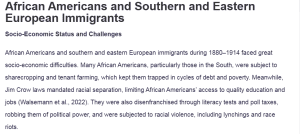African Americans and Southern and Eastern European Immigrants
Socio-Economic Status and Challenges
African Americans and southern and eastern European immigrants during 1880–1914 faced great socio-economic difficulties. Many African Americans, particularly those in the South, were subject to sharecropping and tenant farming, which kept them trapped in cycles of debt and poverty. Meanwhile, Jim Crow laws mandated racial separation, limiting African Americans’ access to quality education and jobs (Walsemann et al., 2022). They were also disenfranchised through literacy tests and poll taxes, robbing them of political power, and were subjected to racial violence, including lynchings and race riots.
Similarly, immigrants from southern and eastern Europe, including Italians, Poles, and Jews, found themselves with low-wage factory and sweatshop jobs, often in lethal conditions. They faced nativism and discrimination.
Besides, immigrants were the targets of organizations like the Immigration Restriction League, which advocated for exclusionary policies. Many resided in crowded tenements in cities like New York and Chicago. They were weakened by unsanitary working and living conditions and health hazards, and all faced language barriers.
Impact of the Industrial Revolution
The Industrial Revolution profoundly impacted both good and bad on African Americans and immigrants from Southern and Eastern Europe. Although the industry provided little employment for African Americans in some northern factories, racial discrimination relegated them mostly to poorly paid service jobs or menial work. It also sparked the Great Migration, where countless people moved north, searching for better prospects for a better life and escaping the Jim Crow laws. Even so, they encountered workplace segregation and could be excluded from labor unions, limiting job security and wages.
For Southern and Eastern European immigrants, the Industrial Revolution created many available factory jobs, but they were paid poorly under exploitative conditions (Moll, 2021). It also contributed to the urbanization of many immigrants, who often clustered in ethnic enclaves where they could maintain ties to the culture. Such immigrants often labored in sweatshops and steel mills, where the work was long, the pay was low, and accidents were common.
References
Moll, I. (2021). The myth of the Fourth Industrial Revolution. Theoria, 68(167), 1–38. https://doi.org/10.3167/th.2021.6816701
Walsemann, K. M., Pearson, J., & Abbruzzi, E. (2022). Education in the Jim Crow South and Black-White inequities in allostatic load among older adults. SSM – Population Health, 19, 101224. https://doi.org/10.1016/j.ssmph.2022.101224
ORDER A PLAGIARISM-FREE PAPER HERE
We’ll write everything from scratch
Question
Week 5 Discussion
Required Resources
Read/review the following resources for this activity:
- Textbook: Chapters 17 (section 17.4), 18 (section 18.3), 19 (sections 19.1, 19.2), and 21 (sections 21.2, 21.4)
- Lesson
- Minimum of 1 scholarly source from the Chamberlain Library resources below:
- Sources for the Week 5 Discussion are available by accessing this link.Links to an external site.
- The “Popular Data Bases” within the Library Guide for scholarly sources and videos via Search Popular History DatabasesLinks to an external site. or the History Library GuideLinks to an external site..
African Americans and Southern and Eastern European Immigrants
Initial Post Instructions
In preparation for the initial post, consider two (2) of the minority groups during 1880–1914:
- Women’s rights activists
- African Americans
- Immigrants from southern and eastern Europe
- Child workers
- Great Plain Indians
Then, in one (1) to two (2) paragraphs, address one (1) of the following:
- Explain the socio-economic status and challenges of your minority groups at the turn of the century. Evaluate how the Industrial Revolution affected your chosen minority groups.
- Analyze how the Progressives brought reform to your selected minority groups. Do you find that the Progressives successfully made government responsive and improved the conditions of your chosen minority group?


